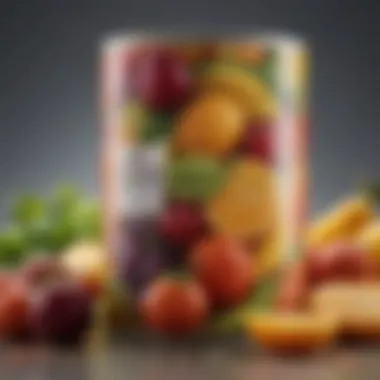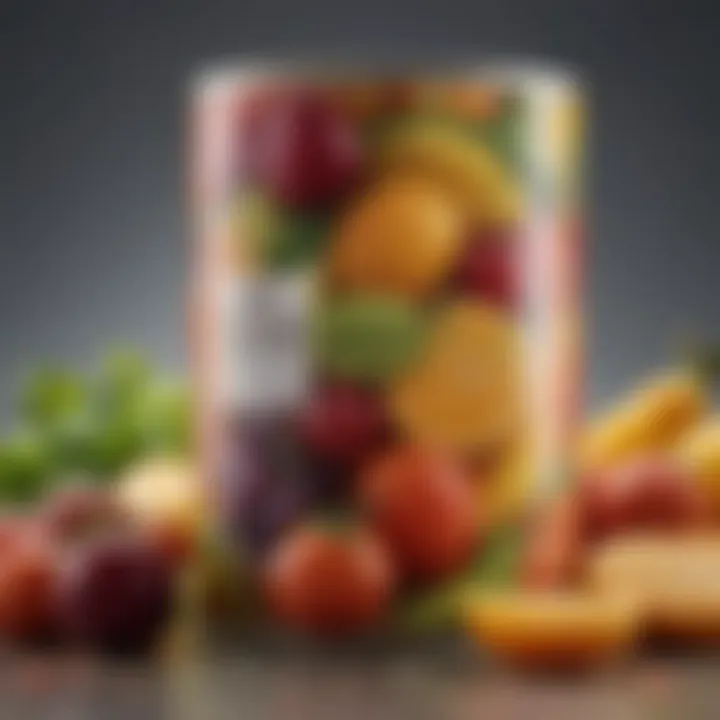Ultimate Guide to Long-Term Food Storage


Intro
In today's fast-paced world, the concept of food storage has become increasingly significant. Understanding which foods are best for long-term storage allows individuals and families to prepare for emergencies, cut down on grocery trips, and reduce food waste. The primary criteria for selecting these food items include shelf life, nutritional value, and practicality. This article will explore these aspects in detail, providing a comprehensive guide that is both informative and useful.
Long-term food storage is not merely about having a stockpile of items. It is about choosing the right foods that will maintain their quality over time and provide essential nutrients when they are needed most. Additionally, effective storage methods and conditions play a vital role in extending the lifespan of food. In the following sections, we aim to provide valuable insights that cater to both food enthusiasts and busy households seeking efficiency in their food supplies.
By the end, readers will gain a broad understanding of which foods hold up best under different storage conditions, how to properly store these items, and practical tips to create a resilient food supply.
Understanding Food Storage
Food storage is an essential aspect of maintaining food quality over time. It involves the methods and conditions in which food is kept to maximize its shelf life, nutritional value, and safety. Understanding food storage is crucial not only for individuals looking to sustain their households but also for ensuring that food remains safe to consume. A proper grasp of storage techniques can reduce food waste, save money, and promote healthier dietary choices.
Importance of Food Storage
The importance of food storage cannot be understated. Effective storage practices allow for the preservation of food items, which in turn can lead to better planning of meals and reduced grocery expenses. Knowing how to properly store food ensures that nutritional integrity is maintained. Furthermore, it contributes to environmental well-being by minimizing food waste, which is a significant global issue. Relying on a stock of long-lasting food provides a sense of security in uncertain times, making it a wise strategy for families.
Factors Affecting Food Shelf Life
Food shelf life can be influenced by a variety of factors, which are essential to consider when selecting items for long-term storage. Understanding these elements can help in making informed choices.
Temperature
Temperature plays a vital role in food preservation. Each type of food has its ideal storage temperature, which can significantly affect its longevity. For example, low temperatures, such as refrigeration, can slow down enzymatic activity that leads to spoilage. On the other hand, higher temperatures may encourage bacterial growth and accelerate degradation. Keeping food items in conditions that prevent damage from heat is a beneficial choice for maximizing shelf life. Moreover, fluctuating temperatures can lead to condensation, which may promote mold and spoilage.
Humidity
Humidity levels are another critical factor in food shelf life. High humidity can create a breeding ground for mold, while low humidity can lead to food items drying out. Many dry foods, like grains and cereals, thrive in cool, dry environments. Understanding how to manage humidity is beneficial for maintaining food quality. An environment with optimal humidity can preserve crunchiness in snacks, while excess moisture can render them stale quickly, proving disadvantageous for storage.
Light Exposure
Light exposure can adversely affect many foods, especially those containing fats or oils. UV radiation can cause nutrient degradation and alter flavors, rendering otherwise safe food unpalatable. Keeping food in opaque or dark containers can help shield it from light, which is a beneficial practice in food storage. Understanding the impact of light exposure provides valuable insight into maintaining food integrity, ensuring flavors remain fresh over time.
Key Criteria for Selecting Storage Foods
Selecting the right foods for long-term storage is crucial. It determines not just the quality of meals you can prepare but also your overall nutrition and financial investment. Numerous factors come into play when assessing the best food options for storage. Key criteria include nutritional value, versatility in cooking, and cost-effectiveness. Each of these elements contributes significantly to the practicalities of food storage in a domestic context.
Nutritional Value
The nutritional value of food should be a primary consideration. Foods rich in vitamins, minerals, and proteins contribute to sustaining overall health, especially in long-term scenarios where immediate access to fresh foods may be limited. Think about items like legumes, which are packed full of essential nutrients. They have a long shelf life, often exceeding a year when stored correctly. In contrast, highly processed foods may be more shelf-stable, but their nutritional quality is often lacking. Furthermore, opting for foods like brown rice or quinoa can ensure that your stored food not only lasts but also supports your health.
Versatility in Cooking
Versatility is another critical factor in choosing storage foods. You want items that can be easily integrated into a wide variety of dishes. For example, canned tomatoes can serve as a base for sauces, stews, or soups. Similarly, canned beans are not only a convenient source of protein but can be added to salads, dips, or main courses. Moreover, possessing versatile storage foods minimizes monotony in meals. An adaptable pantry allows for creativity, making it easier to prepare quick and healthy meals. Thus, always consider how many different types of meals you can create with a specific food item.
Cost-Effectiveness
Finally, consider the cost-effectiveness of your food choices. Buying in bulk often reduces the price per unit and can lead to significant savings over time. However, it’s important to evaluate the long-term usability of the food. High-quality items that may seem expensive upfront can yield better value when they don’t spoil easily and provide good nutrition. Therefore, calculate the cost benefits while keeping in mind the potential waste of purchasing products that have shorter shelf lives.
"Investing in good food storage is not just a financial decision, but a commitment to your well-being."


To conclude, the best foods for storage are those that are nutrient-rich, versatile for cooking, and financially sensible. Considering these criteria can help develop a well-rounded pantry that stands the test of time.
Categories of Food for Long-Term Storage
Food choices for long-term storage are critical in planning a resilient food supply. Not only do these categories provide essential nutrients, but they also offer variety. Having a range of foods ensures a balanced diet during times of scarcity. Understanding which foods last the longest and maintain their quality can significantly help individuals and families prepare for any unforeseen circumstances.
Choosing food for storage involves several factors, including nutritional needs, versatility, and flavor. Each food category serves a distinct role in your pantry, contributing to health and meal-planning efficiency.
Grains and Cereals
Grains and cereals are foundational elements in any long-term food storage plan. They provide energy and are often rich in fiber and other nutrients. Their long shelf life is another reason they are a popular choice.
Rice
Rice is often a staple in many cultures. Its long shelf life can extend up to 30 years if stored properly. A key characteristic is its versatility—you can use rice as a base for many dishes. White rice, in particular, is favored for its durability compared to brown rice, which contains oils that can go rancid. One unique feature of rice is its ability to absorb flavors from accompanying ingredients, enhancing the overall dish.
Oats
Oats are another excellent choice for storage. They are high in fiber and can promote heart health. Whole oats can last about 30 years, while instant variety has a slightly shorter shelf life. Oats are beneficial not only for their nutrition but also as a filling option that can be transformed into various meals, including oatmeal and baked goods. However, flavoring options for oats can become limited if not paired with other ingredients.
Quinoa
Quinoa is unique among grains because it is a complete protein. This makes it a valuable addition, especially for those with limited dietary options. Its shelf life is around 5 years, which is shorter than rice or oats but still substantial. Quinoa is gluten-free and can serve as a side dish or base for salads. Its nutty flavor and texture are appealing, but it does require rinsing before cooking, which can be a disadvantage in some scenarios.
Canned Goods
Canned goods represent a convenient storage solution. They often last between 1 to 5 years, depending on the product. They bring the benefit of ease in meal preparation and extended shelf life.
Vegetables
Canned vegetables are a staple for those looking to stock their pantry. They retain essential nutrients and are easy to prepare. A great characteristic is that they often include varieties not readily available year-round, such as peas or green beans. They are also ready to use and reduce prep time. However, some people may be concerned about sodium content, which can be high in many canned options.
Fruits
Canned fruits offer sweetness and nutrition. They are a good source of vitamins and can last 1 to 2 years in proper conditions. A unique feature is that they can often be canned in juice or syrup, adding to their flavor. However, some varieties might contain added sugars that could be a concern for health-conscious individuals.
Soups
Soups in cans provide excellent convenience. They offer a quick meal option and can be packed with vegetables and proteins. Their shelf life is typically around 2 to 5 years, which allows for flexibility in meal planning. They can be a hearty choice, although some brands may have preservatives, which not everyone prefers to consume.
Dried and Dehydrated Foods
Dried and dehydrated foods are valuable for long-term storage due to their weight and space-saving qualities. Properly stored, they can last for years while retaining most of their nutritional value.
Beans and Legumes
Beans and legumes are protein-rich and can last between 10 to 30 years when dry. They are known for their high fiber content, which supports digestive health. Dried beans require soaking and cooking time but can be used in various recipes, making them quite versatile. The downside is their preparation time may discourage some people.
Jerky


Jerky offers a protein-packed snack option. It is lightweight and can last for a year or more. A significant advantage is its convenience for on-the-go situations, such as hiking or camping. However, jery may have high sodium levels, which could deter health-conscious individuals from frequent consumption.
Freeze-Dried Options
Freeze-dried foods are another excellent addition. They retain most of their nutrients and can last for 25 to 30 years. One of their key characteristics is the preservation of flavor and texture. They are also lightweight and easy to transport. While they are generally more expensive than other storage options, they provide high value in terms of nutrition and versatility.
Fats and Oils
Fats and oils are essential for cooking and can enhance flavors in meals. While generally not stored in large quantities, selecting the right oils can significantly benefit long-term storage.
Coconut Oil
Coconut oil has a high smoke point and offers several health benefits, including medium-chain triglycerides. It has a long shelf life of up to 2 years, making it a practical choice. It remains solid at room temperature, which can be an advantage. However, its distinct flavor may not suit all dishes, limiting its versatility slightly.
Olive Oil
Olive oil is revered for its taste and health benefits. It’s rich in monounsaturated fats, promoting heart health. Though its shelf life is shorter—about 18 to 24 months—it remains popular for cooking and dressings. A unique feature is its range of flavor profiles, from mild to robust, giving cooks options for various culinary needs. However, it should be stored away from light and heat to maintain quality.
Nut Butters
Nut butters, such as almond or peanut butter, offer tasty, nutrient-dense options. They can last for about 1 year, depending upon the variety. A distinctive feature of nut butters is their protein content, making them a favorite among health enthusiasts. However, they may not be compatible with all dietary preferences due to potential allergens.
Best Practices for Food Storage
Effective food storage goes beyond simply placing items in a pantry or fridge. The right practices can significantly enhance the longevity of food. Following best practices ensures that food retains its nutritional value and flavor while minimizing waste. These practices create a structured approach to food management, enabling individuals and families to maintain a reliable supply of ingredients for daily cooking and emergencies.
Optimal Storage Conditions
Creating optimal storage conditions is the first step towards preserving food. Temperature is a key element. Most foods require a cool, dry place while some perishables need refrigeration. Humidity control is also crucial as excessive moisture can lead to spoilage or mold growth. Ensuring containers are sealed properly can mitigate these issues. Exposure to light can degrade food quality, especially for products sensitive to oxidation. Thus, a dark storage area works best for many items. Reinforcing these factors creates a strong foundation for food safety and quality.
Using Proper Containers
Proper containers play an essential role in food preservation. They not only protect the food but also maintain its quality. Choosing the right type affects how long food stays fresh and safe.
Glass Jars
Glass jars offer a classic solution for food storage. Their main characteristic is transparency, which allows easy identification of contents. They are a popular choice because they do not absorb odors or chemicals. A unique feature of glass jars is their airtight lids, which help to prolong shelf life for various items such as grains, pasta, and sauces. However, care must be taken as glass can be fragile, posing a risk of breakage if dropped. In summary, glass jars are both beneficial and visually appealing for storage needs.
Vacuum-Sealed Bags
Vacuum-sealed bags represent a modern method of food preservation. Their key characteristic is the removal of air, which effectively extends shelf life by preventing oxidation. They are particularly useful for meats and vegetables, as they preserve freshness and prevent freezer burn. A distinct advantage of vacuum-sealed bags is their compact size, saving space during storage. On the downside, initial investment costs for a vacuum sealer may deter some users. Yet, for those looking to store bulk items, this method is highly effective.
Food-Grade Buckets
Food-grade buckets are also an excellent option for bulk storage. Their primary characteristics include durability and large capacity. They are common in long-term storage practices, as they can hold a significant volume of dried goods like rice and beans. A unique feature of these buckets is that they can be stacked, making them suitable for limited spaces. However, it is vital to ensure they are food-grade to avoid chemical contamination. Therefore, food-grade buckets are an advantageous choice for those needing robust, ample storage solutions.
Labeling and Rotation
Labeling food storage items is a simple practice that dramatically impacts food safety. It allows for easy identification and aids in keeping track of expiration dates. Implementing a rotation system ensures that older items are used first, minimizing waste. This practice is best known as FIFO, or first in, first out. Developing this habit not only helps in managing what food needs to be consumed first but also guarantees that the items within storage are always fresh. Proper labeling and systematic rotation keep food supplies organized and reduce the risk of spoilage.


Common Mistakes in Food Storage
Understanding common mistakes in food storage is crucial for anyone looking to maintain a reliable food supply. Mistakes can lead to food waste, nutritional loss, and even safety concerns. By avoiding these pitfalls, individuals can ensure that their long-term storage efforts are effective and beneficial. Let’s delve into specific mistakes that people often make and their implications.
Ignoring Expiration Dates
Expiration dates are often seen as mere suggestions, but they serve an essential role in food safety and quality. Ignoring these dates can lead to consuming products that have degraded in flavor, texture, or nutritional value. Each food item has a shelf life, and after this period, beneficial microbes may not be effective. Furthermore, some foods, like dairy products and meats, can pose health risks if consumed after their expiration date. Being aware of these dates and adhering to them can help mitigate these risks and ensure that food quality remains high. It is advisable to check these dates regularly during inventory checks.
Overlooking Temperature Control
Temperature controls are vital in food storage, often overlooked by many individuals. A temperature that is either too high or too low can significantly influence the longevity of food items. For instance, foods stored in excessively hot conditions can spoil faster due to bacterial growth. On the other hand, cold storage might lead to freezer burn in certain items. Therefore, it is imperative to monitor storage temperature consistently. Utilize thermometers in storage areas and store perishable items in the recommended conditions.
"Appropriate temperature control not only prevents spoilage but also preserves nutritional quality, ensuring that food is both safe and beneficial for consumption."
Failing to Perform Regular Inventory Checks
Regular inventory checks are often neglected, leading to mismanagement of stored foods. Without routine checks, items may go unnoticed until they are too outdated to use. This practice can not only result in waste but can also mean missed opportunities to use food in its prime. Keeping an organized inventory system helps track items nearing their expiration and allows for optimal meal planning. Labeling items with their purchase dates can enhance this process. An intended grocery list based on available items can further help minimize unnecessary purchases.
Incorporating a Variety of Foods
In the realm of food storage, the selection of a diverse array of food types cannot be underestimated. A balanced and varied diet contributes significantly to health and well-being. Each type of food offers different nutrients, flavors, and textures, making it essential to integrate a wide selection of items into your long-term storage plan. Not only does this diversity prevent monotony in meals, it also maximizes the nutritional benefits of your stored food inventory.
Balancing Nutritional Needs
When choosing foods for storage, it is crucial to consider their nutritional content. A well-rounded diet includes proteins, carbohydrates, fats, vitamins, and minerals. For instance, beans and legumes provide essential proteins and fiber, while grains like quinoa and rice offer a source of carbohydrates. Including a range of fruits and vegetables, whether they are canned, dried, or freeze-dried, ensures you obtain necessary vitamins and minerals. This meaningful balance supports health and can help in maintaining energy levels amidst various lifestyle demands.
Enhancing Flavor Profiles
Variety in food extends beyond mere nutrition; it significantly impacts taste and enjoyment. Incorporating different food types can elevate the culinary experience. For example, adding herbs and spices can enrich the flavors of stored ingredients. Items like canned tomatoes, canned beans, and freeze-dried vegetables can be a great foundation for sauces and stews, allowing the base flavors to emerge. Furthermore, integrating diverse cooking methods—like baking, stewing, or frying—enhances both texture and flavor, making stored food more appealing.
Adapting to Dietary Preferences
People have different dietary preferences and restrictions. By diversifying storage choices, you accommodate various needs within your household. Whether one prefers vegetarian, vegan, gluten-free, or omnivorous diets, incorporating a variety of foods allows everyone to benefit from your food storage efforts. For example, including gluten-free grains such as quinoa or storing nut butters offers options for those with dietary restrictions. This flexibility enhances meal planning and ensures satisfaction across different dietary preferences.
Diversification of food storage not only caters to nutritional needs but also ensures meal satisfaction and adaptability.
The End
In the realm of food storage, understanding how to select and preserve food effectively is paramount. This article delved into various food categories suitable for long-term storage, revealing the significance of considering elements such as shelf life, nutritional value, and cooking versatility. As individuals and families aim to build a resilient food supply, the insights provided here are not just practical but also essential.
Reflecting upon the various factors discussed, it is clear that choosing the right foods helps in creating a stockpile that remains both nutritious and flavorful over time. Furthermore, the strategies for proper storage can significantly extend the longevity of these items. A keen attention to temperature control, humidity, and light exposure can make a substantial difference in food preservation.
In summation, the knowledge amassed throughout this guide is intended to empower readers. The goal is to foster a more self-sufficient lifestyle through optimal food choices. Moving forward, being informed about diverse food items and storage practices can ensure that one is prepared for various circumstances, enhancing overall well-being and security.
Recap of Key Points
- Selecting foods for storage requires attention to nutritional content and versatility.
- Categories such as grains, canned goods, and dehydrated foods are fundamental to a long-term food supply.
- Storage conditions play a critical role; consider temperature, humidity, and light exposure.
- Recognizing and avoiding common storage mistakes can significantly improve food longevity and safety.
Future Considerations for Food Storage
As food storage practices evolve, it is important to continually reassess the types of foods being stocked. With changing dietary preferences and nutritional science advancing, the focus may shift towards incorporating more plant-based options and sustainably sourced foods. Evaluating one's food storage strategy regularly can help in aligning it with personal health goals.
Moreover, the impact of seasonal changes on food supply cannot be overlooked. Monitoring local produce availability and understanding seasonal cycles can enhance food variety. Emphasizing preparedness for emergencies should also remain a priority. When adapting storage methods, assessing community resources such as local farmers' markets can facilitate better food choices and support local economies.
To stay informed, consider following related discussions online, through platforms like Reddit or Facebook, where ideas about food sustainability and storage are shared and expanded.







